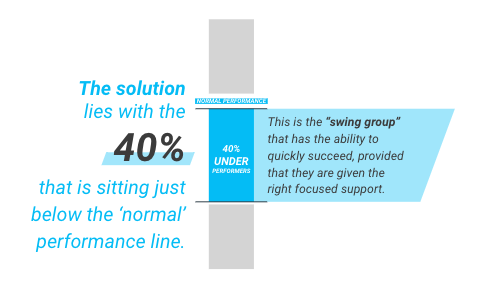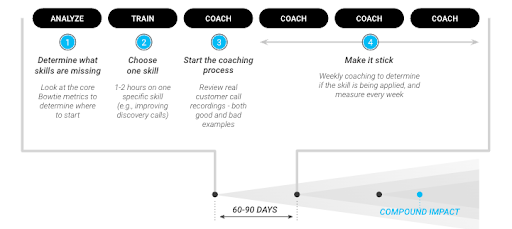Authors:
Jacco van der Kooij
Founder
Winning by Design
Pablo Dominguez
Operating Partner, Sales & Customer Success
Insight Partners
Summary
Underperformance is a critical issue plaguing SaaS companies, and its impact is more severe than many revenue leaders realize. The “Golden Age of SaaS” witnessed a period of overhiring as companies scrambled to meet the market demand for modern SaaS products. While it was easy for employees to succeed in a strong market, the cracks began to show when the market weakened. Currently, two out of three representatives are unable to meet their targets, putting organizations at risk. This overview outlines the causes of underperformance, why traditional solutions are ineffective, and how teams are using a modern sprint-based approach to address this pressing issue.
The Magnitude of the Underperformance Problem
A staggering 68% of the Go-To-Market (GTM) team in SaaS companies is underperforming, with only 32% operating at a “normal” level (meaning, consistently hitting at least 80% of quota). Deepening the issue is the fact that the underperforming cohort delivers significantly less than the “normal” group, with the latter being 1.53 times more productive.
The impact of underperformance
Underperformance affects the entire GTM team, including sales, marketing, and customer success. Sales teams struggle to meet new business quotas, marketers fail to engage ideal customer profile (ICP) accounts effectively, and customer success teams fall short of their net revenue retention (NRR) goals. The composition of the team has also shifted in a significant way, with the percentage of high-performing representatives decreasing to a mere 4%, while the lowest-performing group has increased to 28%.
Why cutting costs alone doesn’t work
Layoffs happening all across SaaS – according to Layoffs.fyi, more than 200,000 layoffs have already taken place in 2023 as of the writing of this article, which already exceeds the total number of tech layoffs in 2022. This is a standard, and often necessary, strategy that leadership applies in order to ensure the viability of a company to get through tough times. And it’s effective for cutting costs, but what next? “These days, companies are good at cutting costs, but not nearly as good at driving productivity,” says Pablo Dominguez, Operating Partner for Sales and Customer Success at Insight Partners. “Once you downsize the team, the remaining team members need to be trained, and their skillsets need to be improved.”
Who your “new” buyer really is
On top of these market challenges, teams now have a “new” buyer. The CFO is far more involved today in purchases, even at lower value thresholds. According to CFO Magazine, 84% of CFOs said they expect to be more involved in developing technology strategy than they were in 2022, and more than a third of those are expected to be “significantly” more involved.
This means that GTM teams “must learn how to understand this new buyer who is taking a far more prominent role on the buying team than in the past,” says Pablo, and effectively address their concerns about budget, ROI of the investment, and alignment with corporate strategic imperatives. So once layoffs occur, the work has only just begun. For the GTM team that remains, the sales playbook and training needs to be adjusted in order to be effective in the market; those who fail to adjust will continue losing deals and seeing their revenue decline further.
Why traditional training programs aren’t working right now
Traditional strategies no longer suffice in the current market landscape. Let’s take a look at a few of these, and examine why they are not working:
- Large-scale training programs, while comprehensive, often fail to deliver immediate impact. These programs cover multiple skills within a single training course, resulting in reps lacking mastery in any specific area. Ongoing coaching and application of these skills are required, extending the time needed to see tangible results.
- Month-long onboarding bootcamps for new reps, which were previously popular, are no longer viable options. Many companies are currently reducing the size of their team, and don’t have the resources to dedicate to running extensive onboarding programs. Further, these programs typically do not measure results and ensure success of the reps before they “graduate” from the bootcamp.
- Rolling out a new methodology is another strategy that falls short in addressing the immediate underperformance challenge. While methodologies are essential for scaling sales teams, their successful implementation requires substantial change management efforts. As a result, they are unable to offer swift resolutions to the current urgent problem.
- Reliance on superstar reps have previously been a massive part of the revenue growth of many companies. But the data indicates a significant decline in the number of superstar reps across many companies. Sales leaders can no longer rely on a small group of high-performing individuals to carry them through difficult market conditions.
Given these limitations of prior solutions, a new approach is required to drive rapid and impactful change in underperforming SaaS companies.
Solving underperformance with Impact Sprints
To drive impactful change within 60-90 days, GTM teams require a solution that focuses on the 40% of underperforming representatives located just below the “normal” performance line. This group has the potential to succeed quickly if provided with the right support. The solution lies in implementing “impact sprints,” inspired by agile software development methodologies.

How to execute your own Impact Sprint
Analyze: Begin by analyzing the team’s key performance metrics to identify areas that require improvement for maximum impact. Whether it’s low net revenue retention or suboptimal contract values due to excessive discounting, select one metric that, when improved, will have a significant positive effect on the business.
Train: Once the skill gap is identified, provide training to employees focused exclusively on that skill. The keys to successful training include maintaining focus on a single skill, starting with simpler skills rather than complex ones, and keeping training sessions concise, lasting one to two hours.
Coach: Coaching is vital to ensuring the new skill becomes ingrained. Weekly repetition and reinforcement over four to six weeks are crucial. Frontline managers must be actively involved in coaching sessions to emphasize their importance. Using actual customer call recordings, demonstrate both successful and unsuccessful examples to facilitate learning moments for the team.

After implementing your first Impact Sprint, introduce subsequent sprints every 60-90 days. The goal is to establish a cadence of ongoing improvement, working towards clear and specific objectives. While the first sprint may not make a massive impact, the focus is on driving continuous improvement over time. By providing targeted support and maintaining a laser-like focus on impact, revenue leaders can elevate the performance of their underperforming employees.
Applying discipline to your continuous improvement effort
With traditional training methods not producing results in the current market, driving growth in SaaS companies requires a different, more targeted approach. Conducting layoffs in order to cut costs is a first step, but then you must increase the performance of the remaining team. SaaS leaders must identify and prioritize the skill gaps, and then execute to improve that skill with discipline.
Garry Kasparov, a chess grandmaster and longtime World Chess Champion, explains it as follows: “weak human + machine + superior process beats stronger humans and machines with inferior processes.” Or said another way, a strong process wins. Ensure that you have a strong process in place, that you can execute with discipline, for the entire team.
By adopting a disciplined sprint-based method outlined above, revenue leaders can prioritize and address one specific skill at a time, providing focused training and ongoing coaching. With diligent focus on skill improvement, revenue leaders can solve the underperformance problem and get back to driving enduring revenue growth.
Insight Partners has several resources available to help your teams:
- Close the skills gaps on your team by enrolling your reps in the appropriate role-based Insight Partners’ Revenue Academy courses, powered by Winning by Design.
- Contact your Insight Partners Account Manager if you would like help with running your own Impact Sprints

